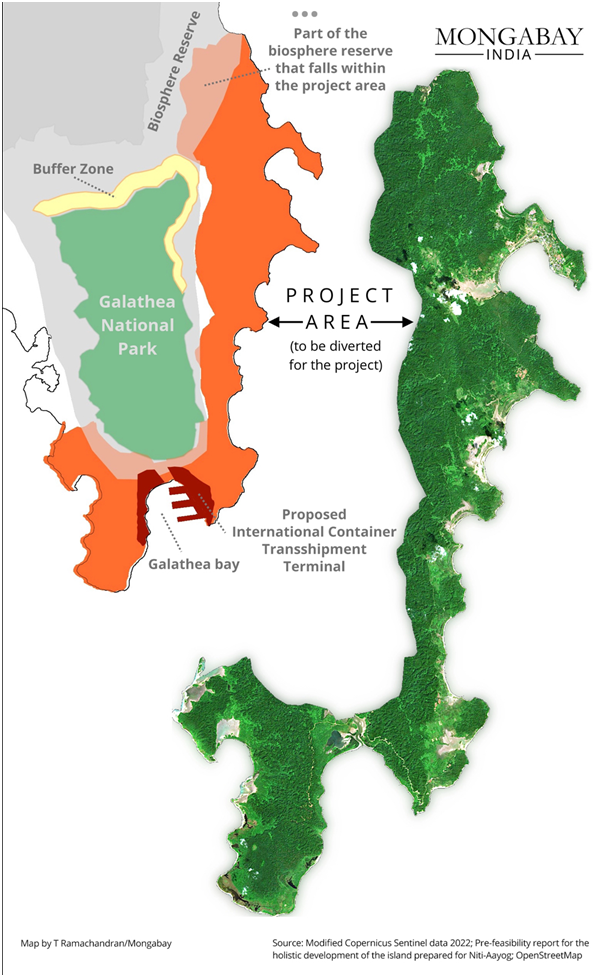A grave mistake in Great Nicobar?
Context: The Union Ministry of Environment, Forest and Climate Change (MoEFCC) has cleared the decks for a mega project at the cost of about ₹70,000 crore at the southern tip of the Andaman and Nicobar Islands.
About the Project
- The ‘Holistic Development of Great Nicobar Island’ project aims to develop
- an international transhipment port of 14.2 mTEU cargo capacity at Galathea Bay along the island’s south-eastern coast
- an international airport to support 4,000 passengers during peak hours
- a 450 MVA gas and solar-based power plant
- an ecotourism and residential township of about 160 sq km.
- The government hopes to establish the offices of multinational corporations by clearing about a million trees in the tropical rain forest and destroying large parts of coral reefs.
- NITI Aayog is piloting the project and the Andaman and Nicobar Islands Integrated Development Corporation is the project proponent.
Issues
- The process towards implementation of this free trade zone and transhipment facility in Great Nicobar, located about 1,650 km from Chennai and 40 nautical miles from the international shipping route, started in September 2020 when the NITI Aayog issued a request for proposals for preparing the master plan for the project.
- In March 2021, AECOM India Private Ltd, a consulting agency, released a pre-feasibility report.
- The MoEFCC’s Expert Appraisal Committee initiated the process of environmental clearance in April, and the project proponent contracted the Hyderabad-based Vimta Labs to prepare the environment impact assessment (EIA) report.
- In December 2021, the Ministry placed the draft EIA report in the public domain for comments and discussion. The quick approvals, clearances, exemptions and de-notifications show that the Union government is keen to implement this project.
1. The Great Nicobar Island has a population of about 8,000. Once completed, the project is expected to attract more than 3 lakh people, which is equal to the current population of the entire 1,000-km-long island chain.
- The ecological and environmental cost of this urbanisation project in an area known for its marine and terrestrial biodiversity appears to have been set aside without any serious consideration.
2. The island, which is spread over 900 sq km, was declared a biosphere reserve in 1989 and included in the UNESCO’s Man and Biosphere Programme in 2013.
More than three-fourth of it is designated as a tribal reserve under The Andaman and Nicobar Islands (Protection of Aboriginal Tribes) Amendment Regulation.
The agenda to convert this pristine island into a commercial hub to compete with the international port in Singapore is nothing but ‘ecocide’.
This project will also run counter to the rights of vulnerable tribal communities, such as the Nicobarese and Shompen, who have been living in these areas for thousands of years and who depend on the forests for survival.
3. To recommend afforestation as a compensation for the loss of forest in the Great Nicobar Island is farcical.
-
-
- The EIA report says compensatory afforestation will be carried out in Haryana and Madhya Pradesh.
- Far-field afforestation, that too in areas that have no ecological comparison, makes no sense.
- The project will end up destroying vast stretches of coral reefs. The report recommends ‘translocation’ of these organisms which are facing an existential threat due to climate change-induced ocean warming.
- Transplanted corals do not have a high survival rate and are susceptible to bleaching, according to various studies.
-
4. The Great Nicobar Island is located close to the epicentre of the 2004 Indian Ocean earthquake which displaced the sea floor by 10-20m vertically as well as trillions of tonnes of undersea rock.
-
-
-
- The EIA report itself admits that “Great Nicobar lies in close proximity to the Ring of Fire and the Tsunami of 26 December 2004 is a clear demonstration of how prone it is to severe natural disasters.
-
-
On international fora, India’s leaders and representatives always highlight the country’s role in championing conservation, sustainability, and green development models. But our optimism is dampened by unsustainable developmental projects such as the one being formulated for Great Nicobar — projects which dilute environmental laws to ease execution. Growth in terms of GDP makes no sense if it ends up in the irretrievable loss of natural capital. It is high time that the Prime Minister’s expressed vision of ‘green developmental model’ becomes the guiding principle for future economic activities.
| Practice Question
1. What are the issues concerning the Great Nicobar Project? Is it sustainable to build such projects in ecologically sensitive zones? |




